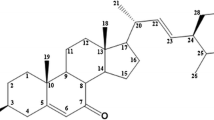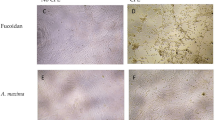Abstract
Among 106 microalgae tested, the cytopathic effect (CPE) upon Vero cells of herpes simplex virus, Type 1 (HSV-1) was inhibited by four methanol extracts of Dunaliella bioculata C-523, D. primolecta C-525, Lyngbya sp. M-9 and Lyngbya aerugineo-coerulea M-12. The green alga, D. primolecta, had the highest anti HSV-1 activity, since 10 μg mL-1 of extract from this alga completely inhibited the CPE. This activity was similar to that of acyclovir at the same concentration. We compared anti-viral activities against adeno virus, herpes simplex virus-2 (HSV-2), Japanese Encephalitis and Polio viruses. Only the CPE of HSV-2 was inhibited. Thus, the factor was specific against HSV. The antiviral activity was apparently excited during HSV adsorption and invasion of the cells. We optimized the conditions for anti HSV-1 activity by prolonging the exposure of HSV-1 to the extract. After 2 h, the CPE of even a high titer of HSV-1 (106 TCID50/0.1 mL) was completely inactivated. By use of various chromatographic techniques, three green substances having anti-HSV activity were purified from the algal mass of D. primolecta, and 5 μg mL-1 of this purified substances completely inhibited the CPE. From the analysis of NMR and MS, the chemical structures of the active substances were identified as pheophorbide-like compounds.
Similar content being viewed by others
References
Ben-Amotz A, Avron M (1982) Glycerol, beta-carotene and dry algal mass production by commercial cultivation of Dunaliella. In Shelf K, Soeder T (eds) Algal Biomass. Elsevier/North-Holland Biochemical Press, Amsterdam: 603-610.
Ben-Amotz A (1995) New mode of Dunaliellabiotechnology: two-phase growth for β-carotene production. J. appl. Phycol. 7: 65-68.
Borowitzka MA (1986) Micro-algae as sources of fine chemicals. Microbiological Sciences 3: 372-375.
Borowitzka MA (1995) Microalgae as sources of pharmaceuticals and other biologically active compounds. J. appl. Phycol. 7: 65-68.
Borowitzka LJ, Borowitzka MA, Moulton TP (1984) The mass culture of Dunaliella salinafor fine chemicals: From laboratory to pilot plant. Hydrobiologia 116/117: 115-121.
Cannell RJP (1993) Algae as a source of biologically active products. Pestic. Sci. 39: 147-153.
Cardllina II JH, Moore RE (1979) Structure and absolute configuration of malygolide, an antibiotic from the marine blue-green alga Lyngbya majusculagomont. J. org. Chem. 44: 4039-4043.
Ehresmann DW, Deig EF, Hatch MT, DiSalvo LH, Vedros NA (1977) Antiviral substances from california marine algae. J. Phycol. 13: 37-40.
Elion GB, Furman PA, Fyte JA, Miranda PD, Beauchamp L, Schaeffer HJ (1977) Selectively of action of antiherpetic agent, 9-(2-hydroxyethoxymethyl) guanine. Proc. natl. Acad. Sci. 74: 5716-5720.
Gerwick WH, Reyes S, Alvarado B (1987) Two malyngamides from the caribbean cyanobacterium Lyngbya majuscula. Phytochemistry 26: 1701-1704.
Jensen A (1993) Present and future needs for algae and algal products. Hydrobiologia 260/261: 15-23.
Mason CP, Edwards KR, Carlson RE, Pignatello J, Gleason FK, Wood JM (1982) Isolation of chlorine-containing antibiotic from the freshwater cyanobacterium Scytonema hofmanni.Science 215: 400-402.
Moore RE (1982) Toxins, anticancer agents, and tumor promotors from marine prokaryotes. Pure appl. Chem. 54: 1919-1934.
Ohta S, Chang T, Kawashima A, Nagate T, Murase M, Nakanishi H, Miyata H, Kondo M (1994) Anti methicillin-resistant Staphylococcus aureus(MRSA) activity by linolenic acid isolated from the marine microalgae Chlorococcum HS-101. Bull. envir. contam. toxicol. 52: 673-680.
Ohta S, Shiomi Y, Kawashima A, Aozasa O, Nakao, T, Nagate T, Kitamura K, Miyata H (1995) Antibiotic effect of linolenic acid from Chlorococcumstrain HS-101 and Dunaliella primolectaon methicillin-resistant Staphylococcus aureus. J. appl. Phycol. 7: 121-127.
Patterson GML, Baker KK, Baldwin CL, Bolis CM, Caplan FR, Larsen LK, Levine IA, Moore RE, Nelson CS, Tschappat KD, Tuang GD, Boyd MR, Cardellina II JH, Collins RP, Gustafson KR, Snader KM, Weislow OS, Lewin RA (1993) Antineoplastic activity of cultured blue-green algae (Cyanophyta). J. Phycol. 29: 125-130.
Reichelt JL, Borowitzka MA (1984) Antimicrobial activity from marine algae; results of a large-scale screening programme. Hydrobiologia 116/117: 158-168.
Richmond, A (1986) Outdoor mass culture of microalgae. In Richmond, A (ed) CRC Handbook of Microalgal Mass Culture, Boca Raton, FL, 285-329.
Rippka R, Deruelles J, Waterbury JB, Herdman M, Stanier RY (1979) Generic assignments, strain histories and properties of pure cultures of cyanobacteria. J. gen. Microbiol. 111: 1-61.
Schaeffer HJ, Beauchamp L, Miranda PD, Elion GB, Bauer DJ, Collins P (1978) 9-(2-hydroxyethoxymethyl) guanine activity against viruses of the herpes group. Nature 272: 583-585.
Author information
Authors and Affiliations
Rights and permissions
About this article
Cite this article
Ohta, S., Ono, F., Shiomi, Y. et al. Anti-Herpes Simplex Virus substances produced by the marine green alga, Dunaliella primolecta. Journal of Applied Phycology 10, 349–356 (1998). https://doi.org/10.1023/A:1008065226194
Issue Date:
DOI: https://doi.org/10.1023/A:1008065226194




